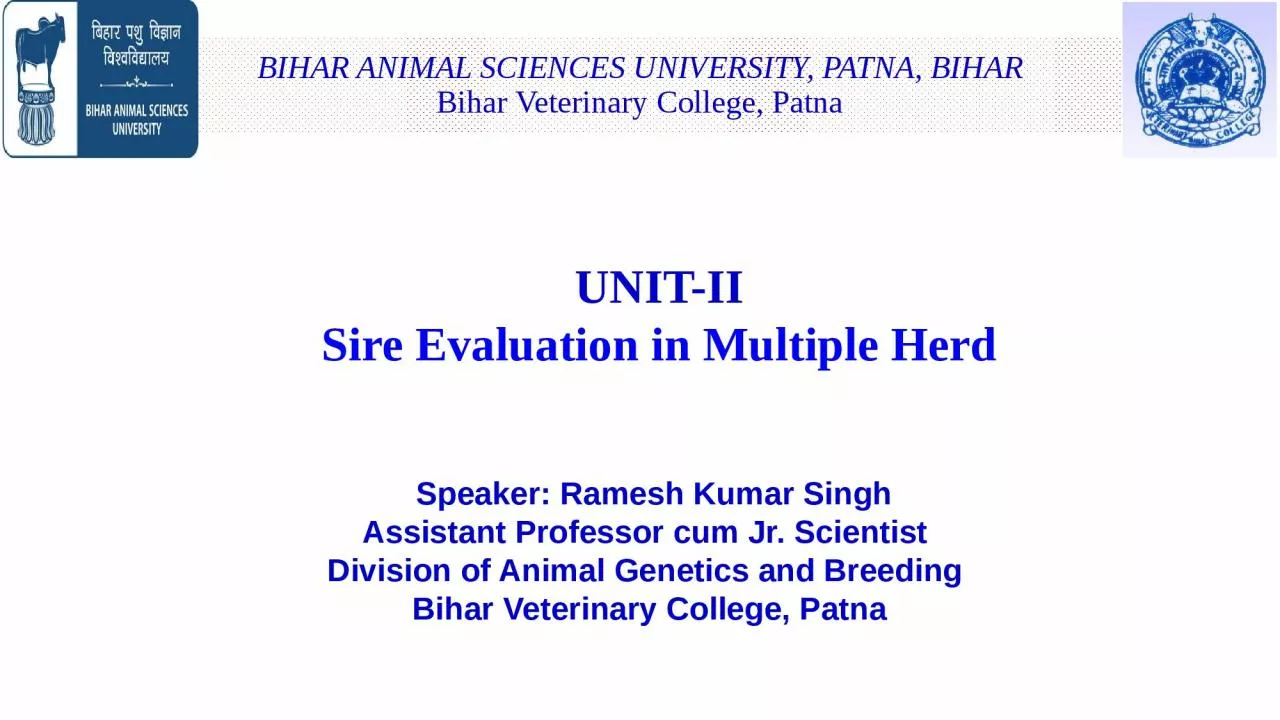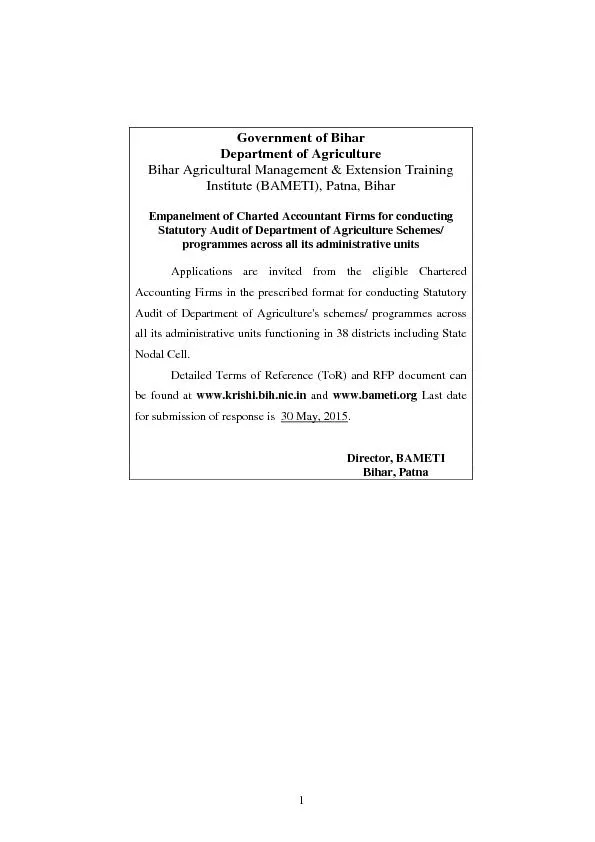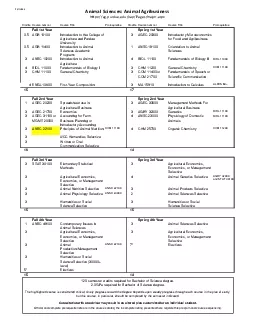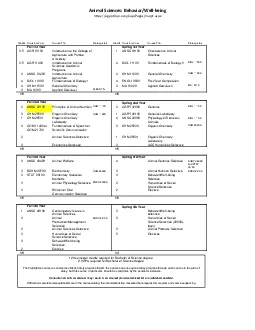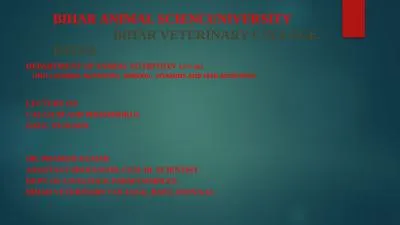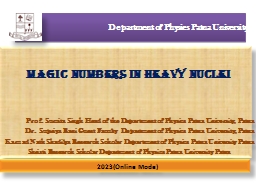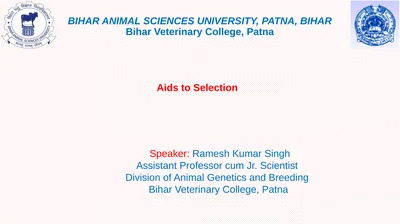PPT-BIHAR ANIMAL SCIENCES UNIVERSITY, PATNA, BIHAR
Author : clara | Published Date : 2022-06-11
Bihar Veterinary College Patna Speaker Ramesh Kumar Singh Assistant Professor cum Jr Scientist Division of Animal Genetics and Breeding Bihar Veterinary College
Presentation Embed Code
Download Presentation
Download Presentation The PPT/PDF document "BIHAR ANIMAL SCIENCES UNIVERSITY, PATNA,..." is the property of its rightful owner. Permission is granted to download and print the materials on this website for personal, non-commercial use only, and to display it on your personal computer provided you do not modify the materials and that you retain all copyright notices contained in the materials. By downloading content from our website, you accept the terms of this agreement.
BIHAR ANIMAL SCIENCES UNIVERSITY, PATNA, BIHAR: Transcript
Bihar Veterinary College Patna Speaker Ramesh Kumar Singh Assistant Professor cum Jr Scientist Division of Animal Genetics and Breeding Bihar Veterinary College Patna UNITII Sire Evaluation in. of Bihar pplications are invited in the prescribed proforma upt 0500 PM o 20112014 for filling the vacancies for the Post of Assi tant Professor in the Pay Scale as recommended by the University Grants Commission from time to time and accepted by th of Bihar pplications are invited in the prescribed proforma upt 0500 PM o 20112014 for filling the vacancies for the Post of Assi tant Professor in the Pay Scale as recommended by the University Grants Commission from time to time and accepted by th Moderately resistant to early blight and tolerant to Potato Leaf Roll Virus PLRV Slow rate of degeneration Can tolerate temperature and water stress to some extent Crop matures in 110120 days A verage yield is 40 tha T olerant to late blight disease V College Patna 800 014 Bihar Gaya Campus House No 1613 Ward No 9A New 38 Area Bisar Gaya 823001 Bihar Adv No CUB Advt 201 dated 16 201 Non Teaching Positions Applications on prescribed form are invited from the eligible Indian citizens for appointm Introduction urprising as it may sound cerebral edema is a fairly common pathophysiological entity which is encountered in many clinical conditions Many of these conditions present as medical and surgical emergencies By definition cerebral edema is 1 Department of Agriculture Bihar Agricultural Management & Extension Training Institute (BAMETI), Patna, Bihar Empanelment of Charted Accountant Firms for conducting Statutory Audit of Department PATNA YUVA . EDUCATION FAIR 2014. . INDIA’S PREMIER EDUCATION&CAREER FORUM. First time in PATNA. Live Telecast Reputed on T. V CHANNEL. . Dr. . Anant. Kumar. H.O.D. Department of Chemistry. Bakhtiyarpur. College of Engineering Patna. SPECIFICATION OF WATER. (. i. ) Boilers:- . Zero hardness.. Hard water:-. (a) prevents efficient heat transfer by scale formation . BIHAR – Fact File. BIHAR STATE BRIDGE CONSTRUCTION CORPORATION LIMITED. Bihar lies mid-way between the humid West Bengal in the east and the sub humid Uttar Pradesh in the west which provides it with a transitional position in respect of climate, economy and culture. It is bounded by Nepal in the north and by Jharkhand in the south. The Bihar plain is divided into two unequal halves by the river Ganga which flows through the middle from west to east.. Fall 2014https//agpurdueedu/oap/Pages/majoraspxCreditsCourse numberCourse TitlePrerequisitesCreditsCourse numberCourse TitlePrerequisitesFall 1st YearSpring 1st Year05AGR 10100Introduction to the Coll https//agpurdueedu/oap/Pages/majoraspxCreditsCourse numberCourse TitlePrerequisitesCreditsCourse numberCourse TitlePrerequisitesFall 1st YearSpring 1st Year05AGR 10100Introduction to the College of Ag BIHAR VETERINARY COLLEGE, PATNA. Department of Animal Nutrition. ANN-602. UNIT-I (ANIMAL NUTRITION- Mineral, Vitamins and Feed Additives). Lecture on. Calcium and Phosphorus. Date- 03/10/2020. . Magic . numbers in heavy nuclei. Prof. Sumita Singh Head of the Department of Physics. . Patna University, Patna. Dr. Supriya Rani Guest Faculty Department of Physics. . Patna University, Patna . BIHAR ANIMAL SCIENCES UNIVERSITY, PATNA, BIHAR Bihar Veterinary College, Patna Speaker: Ramesh Kumar Singh Assistant Professor cum Jr. Scientist Division of Animal Genetics and Breeding Bihar Veterinary College, Patna Aids to Selection Aids
Download Document
Here is the link to download the presentation.
"BIHAR ANIMAL SCIENCES UNIVERSITY, PATNA, BIHAR"The content belongs to its owner. You may download and print it for personal use, without modification, and keep all copyright notices. By downloading, you agree to these terms.
Related Documents

